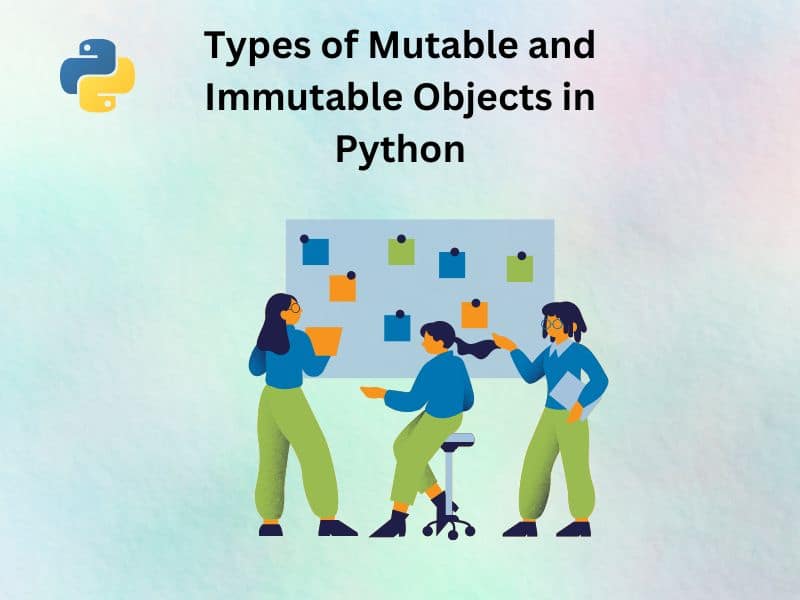Types of Mutable and Immutable Objects in Python

When it comes to working with objects in Python, it’s important to understand the difference between mutable and immutable objects. Mutable objects can be changed after they have been created, while immutable objects cannot be altered once created. Both types of objects are useful, so let’s take a look at the differences between mutable and immutable objects in Python.
Mutable objects can be changed after creation. This means you can add elements to an existing object or change its contents, such as a list or dictionary. You can also assign a different value to an explicit variable that refers to a mutable object, which will cause it to reference a different object altogether. Modifying the contents of a mutable object does not create a new object – it only changes the existing one.
Immutable objects cannot be changed after creation. Examples of immutable objects in Python include integers, strings, tuples and frozen-sets. When you assign or refer to an explicit variable that points to an immutable object, you cannot change the contents of the referenced object (for example, you can’t add items to a tuple). If you need to change something like this, then you must create a new version of the original object and assign/refer to that instead.
In summary, understanding when working with mutable and immutable objects in Python is crucial for writing code that will execute effectively without creating unexpected side effects and causing errors that could crash your program. Learning how each type works may seem daunting at first but will become second nature with practice!
Benefits of Using Mutable and Immutable Objects in Python
Looking to become a more effective programmer in Python? Learning the benefits of mutable and immutable objects is one way to achieve that. In this article, we will look into what makes these objects unique, how they can be used in coding, and why they are important to understand.
When modifying data or assigning variables, mutable and immutable objects each handle their object state changes differently. A mutable object can be changed after instantiation while immutable objects cannot. Mutable objects are typically easier for programmers to use but can cause memory issues since the same object in memory is changed every time it is called. On the other hand, an immutable object must create a different instance each time it is changed which increases memory efficiency but may be more difficult for programmers to work with.
Data Science Training in Bangalore
The two main types of mutable objects in Python are lists and dictionaries. Lists contain elements that can be modified through addition, deletion, or replacement of elements. Dictionaries are comprised of key/value pairs and they support addition, deletion, and substitution of values through keys. Immutable objects include strings and tuples; strings have fixed length characters which cannot be changed once the string is created while tuples cannot be modified once created either though its elements can still point to mutable objects such as lists or dictionaries.
Knowing how and when to utilize both mutable and immutable objects in Python correctly significantly improves code performance and memory usage since the correct type of object avoids wasted resources caused by inefficient loops or other code mistakes resulting from unawareness about their purposes. By understanding the differences between these two data types as well as their various uses you can ensure your code will run smoother and faster than ever before!
Strategies for Effectively Working with Both Types of Objects in Your Code
When working with objects in Python, it’s important to understand the difference between mutable and immutable objects. A mutable object can be modified or changed, while an immutable object cannot. To effectively work with both types of objects in your code, you will need to identify each object’s type and know what operations are appropriate for it.
The main difference between mutability and immutability lies in when data is modified; if an object can be modified after it is created then the object is mutable, while if the data cannot be changed after creation, then the object is considered immutable. Knowing which type of object, you are working with will help you decide what operations are appropriate. For example, with lists (a mutable collection in Python) it’s possible to add new elements or delete existing ones; however, with strings (an immutable sequence of characters) it’s impossible to modify characters within the string once created.
Best practices for working with objects in code include isolating data manipulation from other operations as much as possible. This practice increases code clarity by improving the readability of your code, making it easier for other developers to understand and maintain it. Additionally, depending on your application you may want to consider using one type of object over the other; for instance, if data integrity or safety is a priority then immutable objects may be more suitable than their mutable counterparts since they can’t easily be altered.
Data Analyst Course in Mumbai
In summary, understanding when to use each type of object can help ensure that your code runs smoothly and efficiently while being easy to read and maintain by others.
